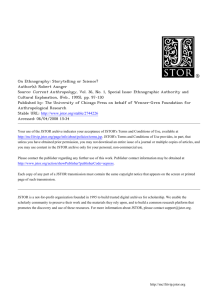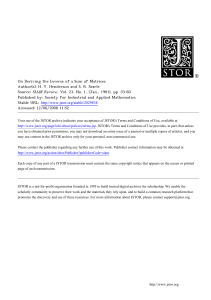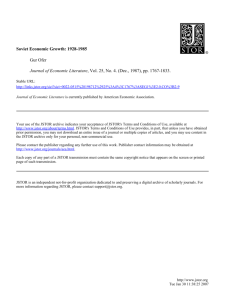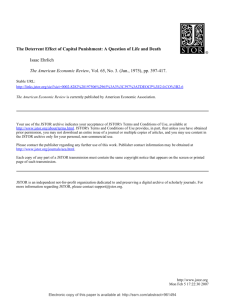Some Empirical Consequences of the Davis
advertisement
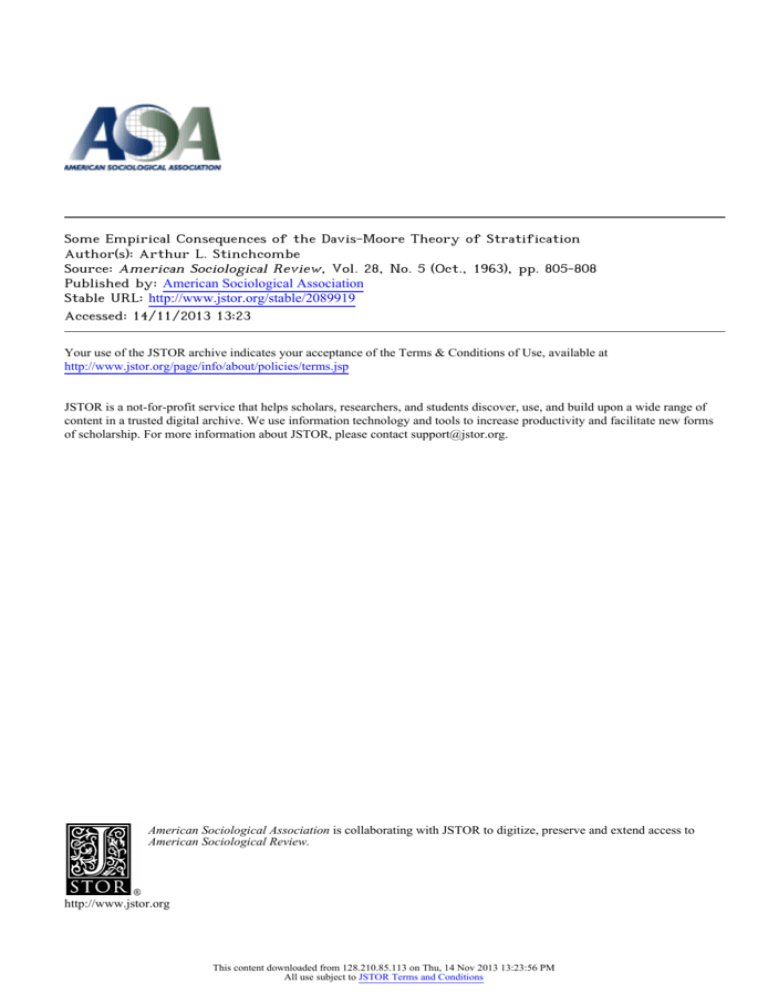
Some Empirical Consequences of the Davis-Moore Theory of Stratification Author(s): Arthur L. Stinchcombe Source: American Sociological Review, Vol. 28, No. 5 (Oct., 1963), pp. 805-808 Published by: American Sociological Association Stable URL: http://www.jstor.org/stable/2089919 . Accessed: 14/11/2013 13:23 Your use of the JSTOR archive indicates your acceptance of the Terms & Conditions of Use, available at . http://www.jstor.org/page/info/about/policies/terms.jsp . JSTOR is a not-for-profit service that helps scholars, researchers, and students discover, use, and build upon a wide range of content in a trusted digital archive. We use information technology and tools to increase productivity and facilitate new forms of scholarship. For more information about JSTOR, please contact support@jstor.org. . American Sociological Association is collaborating with JSTOR to digitize, preserve and extend access to American Sociological Review. http://www.jstor.org This content downloaded from 128.210.85.113 on Thu, 14 Nov 2013 13:23:56 PM All use subject to JSTOR Terms and Conditions EMPIRICAL CONSEQUENCES OF THE DAVIS-MOORE THEORY 805 SOME EMPIRICAL CONSEQUENCES OF THE DAVIS-MOORE THEORY OF STRATIFICATION * ARTHUR L. STINCHCOMBE The Johns Hopkins University Davis and Moore's theory of stratification,1 though frequently discussed,has stimulated remarkably few studies. Perhaps this is due to the lack of derivations of empirical propositions in the original article. I would like in this note to outline some empirical implicationsof the theory. Davis and Moore's basic argument is that unequal rewards tend to accrue to positions of great importanceto society, provided that the talents needed for such positions are scarce. "Society" (i.e. people strongly identified with the collective fate) insures that these functions are properly performed by rewarding the talented people for undertaking these tasks. This implies that the greater the importance of positions, the less likely they are to be filled by ascriptive recruitment.2 It is quite difficult to rank tasks or roles according to their relative importance. But certain tasks are unquestionably more important at one time than at another, or more important in one group than another. For instance, generalsare more importantin wartime than in peacetime. Changes in importance, or different importance in different groups, have clear consequencesaccording to the theory. If the importance of a role increases, its rewards should become relatively greater and recruitmentshould be more open. The following empirical consequences of the theory are "derivations" in a restricted sense. We identify supposed changes in the importance of roles, or identify groups in which certain roles are more important.Then we propose measures of the degree of inequality of reward and openness of recruitment which are consequences of such changes. If changes in importance are correctly identified, and if the measures of inequality of reward are accurate, then the consequencesare logical derivations from the theory. If it turns out that generals are not more recruited according to talent in wartime, then it may be because the theory is untrue. But it may also be that generals are not in fact more important in wartime, or that our measures of recruitment do not work. Consequence 1: In time of war the abilities of generals become more important than in time of peace. Accordingto the theory, this should result in the following types of restructuring of the stratification system during wartime (and the reverse with the onset of peace): (a) The rewards of the military, especially of the elite whose talents are scarce, should rise relative to the rewards of other elites, especially those which have nothing to do with victory (e.g., the medical and social service elite charged with care of incurables,the aged, etc.).3 (b) Within the military, the degree of inequality of rewards should become greater, favoring generals, for their talents are particularly scarce. (c) Even standardizing for the increase *This note was stimulated by a seminar presentation by Renate Mayntz, who focused attention on the problem of empiricalinvestigationof functional theories. IKingsley Davis and Wilbert E. Moore, "Some Principles of Stratification,"AmericanSociological Review, 10 (April, 1945), pp. 242-249. 2 The theory holds that the most importantpositions, if they require unusual talents, will recruit people who otherwisewould not take them, by offering high rewards to talent. This result would take place if one assumeda perfectly achievementbased stratificationsystem. Some have assertedthat Davis and Moore'sargument"assumes"such a perfectly open system, and hence is obviously inadequate to the facts. Since the relevantresultswill be obtainedif a system recruitsmore talented people to its "important"positions but ascribesall others, and since this postulate is not obviously false as is 3 This very interestingcase is treated in Willard the free market assumption, we will assume the weakerpostulatehere. It seems unlikely that Davis Waller, "War and Social Institutions," 478-532, and Moore ever assumed the stronger, obviously esp. 509-511,in W. Waller,(ed.), Warin the Twentieth Century,New York: Dryden, 1940. false,postulate. This content downloaded from 128.210.85.113 on Thu, 14 Nov 2013 13:23:56 PM All use subject to JSTOR Terms and Conditions 806 AMERICAN SOCIOLOGICALREVIEW in sheer numbers of high military officials (which of itself implies that more formerly obscure men will rise rapidly) there should be pressure to open the military elite to talent, and consequently, there should be a higher proportion of Ulysses S. Grant type careers and fewer time-servers. (d) Medals, a reward based on performances rather than on the authority hierarchy, should behave the same way. They should be more unequally distributed in wartime within any given rank; new medals, particularly of very high honor, should be created in wartime rather than peacetime, etc. Consequence 2: The kingship in West European democratic monarchies has consistently declined in political importance as the powers of parliamenthave increased (this does not apply, for instance, to Japan, where apparently the Emperorship was largely a ritual office even in medieval times). Modern kings in rich countries now perhaps have other functions than political leadership. Certainlythe role requirementshave changed -for instance, a modern king's sex life is much more restricted than formerly. Their rewards have also changed, emphasizing more ceremonial deference and expressions of sentiment, less wealth and power. It is not clear whether the ceremonialelement has actually increased, or whether the rewards of wealth and power have declined. Investitures in the Presidency in the United States and Mexico seem to have nearly as much pomp as, and more substance than, coronations in Scandinavia and the Low Countries. Changes in the nature of the role-requirements and of the rewardsindicates a shift of functions. At the least these changes indicate that some ceremonial functions of the kingship have declined much less in importance than the political functions. But to have a non-political function in a political structure is probably to be less important in the eyes of the people. Consequently, historical studies of the kingship in England, Scandinavia, and the Low Countries should show: (a) The decline of the rewards of kingship relative to other elites. (b) Progressively more ascriptive recruitment to the kingship. This would be indicated by (I) fewer debates over succession rules, less changing of these rules in order to justify getting appropriate kings, and fewer successions contested by pretenders; (II) fewer "palace revolutions"or other devices for deposing incompetent or otherwise inappropriate kings; and (III) less mythology about good and bad kings, concerning performance of the role, and more bland human interest mythology focussed on what it is like to occupy an ascribed position. Consequence 3: In some industries individual talent is clearly a complementaryfactor of production, in the sense that it makes other factors much more productive; in others, it is more nearly additive. To take an extreme case of complementarity,when Alec Guiness is "mixed" with a stupid plot, routine supporting actors, ordinary production costs, plus perhaps a thousand dollars for extra makeup, the result is a commercially very successful movie; perhaps Guiness increases the value of the movie to twice as much by being three times as good as the alternative actor. But if an equally talented housepainter (three times as good as the alternative) is "mixed" with a crew of 100 average men, the value of the total production goes to approximately 103 per cent. Relatively speaking, then, individual role performance is much more "important" in the first kind of enterprise.Let us list a few types of enterprisesin which talent is a complementary rather than additive factor, as comparedwith others which are more nearly additive, and make the appropriate predictions for the whole group of comparisons: Factor Talent Complementary Research Universities Entertainment Management Teams in athleticsand other "winnertake all" structures Violinconcertos TalentNearly Additive Teaching Undergraduatecolleges High schools Manufacturing Manualwork Groups involved in ordinary competitionin which the rewardsare divided among the meritorious Symphonies This content downloaded from 128.210.85.113 on Thu, 14 Nov 2013 13:23:56 PM All use subject to JSTOR Terms and Conditions EMPIRICALCONSEQUENCESOF THE DAVIS-MOORETHEORY For each of these comparisonswe may derive the following predictions: (a) The distribution of rewards (e.g., income distributions) should be more skewed for organizations and industries on the left, whereas the top salaries or honors should be nearer the mean on the right. In organizations with ranks, there should be either more ranks or greater inequality of rewardswithin ranks on the left. (b) Since the main alternative to pure achievement stratification in modern society is not ascription by social origin, but rather ascriptionby age and time-in-grade,seniority should determinerewardsless in the systems on the left than on the right. There are of course many ways to measure it. For instance, men at the top of the income distribution in groups on the left should have reached the top at an earlier age those those on the right. There should also be a higher proportion of people whose relative income has declined as time passes in the talentcomplementary industries and groups. Other easily accessible empirical consequences of the theory are suggested by the increased importance of the goal of industrialization in many countries since World War II, the rise in the importance of international officials during this century, and the increased importance of treatment goals in mental hospitals. Since these consequences are easy to derive, we may omit their explication here. Another set of derivations can be made if we add a postulate that a bad fit between functional requirements and the stratification system makes people within the group (and particularly those strongly identified with the group) perceive the system as unfair. For example, this postulate together with the others would imply that where talent is a complementary factor, those organizations with seniority stratification systems should create more sense of injustice than those in which the young shoot to the top. In addition, the alienation should be greatest among those more committed to group goals in seniority dominated talentcomplementarygroups, whereas it should be greatest among those less committed to the group where there is an achievement system. All these consequencesought to be reversed, 807 or at least greatly weakened, for groups where talent is an additive factor. It may be useful to present briefly a research design which would test this consequence of the theory. Suppose we draw a sample of colleges and universities, and classify (or rank) them on the importance of research within them. Perhaps a good index of this would be the number of classroom contact hours divided by the number of people of faculty rank on the payroll, which would be lower, the greater the importance of research relative to teaching. Within each of the institutions we compute a correlationcoefficientbetween age and income of faculty members. (Since the relation between age and income strikes me in this case as being curvilinear, some transformation of the variables will be appropriate.) The higher the correlation coefficient, the more seniority-dominated the stratification system of the institution.4 The first hypothesis that we can immediately test is that this correlation coefficient should be generally smaller in research-dominatedinstitutions. This is a direct consequence of the functional theory as originally stated. Then we could divide institutions into four groups, according to whether they are researchor teaching institutions and whether they are seniority-dominated or not. We could ask the faculty within a sample of such institutions a series of questions which would sort out those highly devoted to their work and to staying in the system, and those not highly devoted. At the same time we could ask them to agree or disagree with some such statement as "Most faculty promotions in this school go to the people who deserve them most." According to the functional theory with the added postulate on the sense of justice, we could predict results 4An elimination system, in which young people are either fired or given raises, depending on their performance, will also produce a high correlation between age and income within an institution, and yet may produce (if the institutions with such elimination systems have markedly higher salary scales), in the higher educational system as a whole, a lower correlation. I doubt if the appropriate adjustments for this would substantially affect the analysis except for a very few institutions, but this is of course an empirical question. The adjustments could be made, theoretically, by including the people who have been fired, with their current incomes, in the institutions which fired them. This content downloaded from 128.210.85.113 on Thu, 14 Nov 2013 13:23:56 PM All use subject to JSTOR Terms and Conditions REVIEW AMERICANSOCIOLOGICAL 808 TABLE 1. HYPOTHETICALPROPoRTIoN THINKING "MOST FACULTY PROMOTIONSGo TO THE PEOPLE WHO DESERVE THEM MOST Institutions with Mostly Teaching Functions and Substantial Research Functions and Seniority Systems Achievement Systems Achievement Systems Seniority Systems Proportion Thinking the System is Fair Faculty with Strong commitments Weak commitments High Low approximately according to the pattern in Table 1. But adding postulates goes beyond the original theory into the mechanismsby which the functional requirementsget met, which is an undevelopedaspect of functional theory generally. I do not intend to investigate the truth of Low High Low High High Low any of these empirical consequences of the theory here. The only purpose of this note is to point out that functional theories are like other scientific theories: they have empirical consequenceswhich are either true or false. Deciding whether they are true or false is not a theoretical or ideological matter, but an empirical one. This content downloaded from 128.210.85.113 on Thu, 14 Nov 2013 13:23:56 PM All use subject to JSTOR Terms and Conditions



